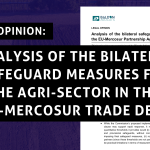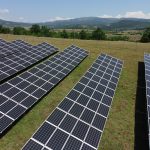The EU’s post-2022 Common Agricultural Policy (CAP) will play a crucial role in tackling the climate crisis. While the trilogues are ongoing between the EU legislators, Member States have already started developing their national CAP Strategic Plans. CAN Europe members assessed five Member States’ draft Strategic Plans. The report reveals that the national Strategic Plans would require serious revisions, if the Member States are to deliver their climate, energy and biodiversity objectives under the European Green Deal.
Once the rules of the post- 2022 CAP are agreed, Member States will implement them through “CAP Strategic Plans” designed at national level and monitored by the European Commission. The report “Will CAP Strategic Plans help deliver much needed climate action?” focuses on CAP specific “objective 4 : agriculture and climate mitigation” and looks into measures that Member States proposed in their draft documents.
For Denmark, the report details that Danish livestock intensive agriculture results in much higher greenhouse gas emissions from agriculture than EU27-average. However, neither the Danish SWOT or the EU recommendations to Denmark sets a target for reducing livestock emissions or intensity. In contrast the Danish SWOT argues for continued climate inaction. The Danish NGO Network, Danish 92 Group calls upon the government to climate-proof the Danish post-2022 CAP Strategic Plan by cutting livestock emissions by 50% by 2030, increasing soil organic carbon, rewetting peatlands and substituting imported soy with domestic grass protein production.
Dan Belusa, from the Danish NGO Network, The Danish 92 Group said: “Denmark needs in its CAP strategic plan to set an ambitious sector target for the reductions in agriculture, if it is serious to implement its economy-wide target of reducing its emissions by 70% by 2030. For decades Danish agriculture has been exempt from climate action. Especially, a reduction target of halving livestock will have multiple benefits also for the environment and biodiversity that is still declining”.
In France, while the agricultural sector is responsible for 20% of emissions originating in the country, the draft CAP Strategic Plan fails to include the sectoral emissions reduction target from the French National Low Carbon Strategy. The report reminds that the objectives from the National Low Carbon Strategy for 18% emissions reductions by 2030 and 46% emissions reductions by 2050 in the agricultural sector must be emphasised in the national CAP Strategic Plan.
Cyrielle Denhartigh from the French NGO Network, Réseau Action Climat France said: “French Agriculture Ministry’s lack of ambition on environmental and climate issues is worrying. The French CAP Strategic Plan should be used to implement CAP’s support tools to ensure a more climate friendly and resilient agriculture system.”
For Germany, the report underlines that both the National Energy and Climate Plan and the needs assessment for the CAP Strategic Plan state that the national target for emissions reduction from agriculture can only be achieved if livestock numbers are effectively reduced and emissions from peatland and organic soils are reduced. However, the conditionalities nor any of the eco-schemes listed in the draft CAP Strategic Plan directly address these sectors.
Tobias Reichert from Germanwatch said: “Achieving the German Greenhouse gas reduction target for agriculture can only be achieved by a fundamental reform of the livestock sector resulting in a closer link between animal numbers and agricultural land and lower total livestock numbers. To achieve this, CAP funds must not support industrial livestock systems but give incentives for extensification and practices such as sustainable grazing and grassland management.”
The assessment of Ireland’s draft CAP Strategic Plans, reminds that in the country’s “2020-2027 roadmap for dairy”, the state agricultural research agency anticipated a further 12% increase in dairy cow numbers before 2027. This creates a fundamental conflict between the current policies for continued dairy expansion and the need for climate mitigation in the future CAP. The draft CAP Strategic Plan should be aligned with the Irish government’s commitment to 7% annual greenhouse gas emissions reductions and its international obligations under the Paris Agreement.
Ian Lumley from the Irish NGO, An Taisce, said : “Ireland is an EU outlier in dairy expansion. Having declared a ‘Climate Emergency’ in parliament and with a current coalition Programme for Government annual GHG emission reduction target of 7% until 2030, the National CAP Plan must ensure that agriculture plays its fair share in climate action. This requires significant herd reduction.
For Spain, the report reminds that the model calculating the amount of basic payment rights used to implement the CAP for the period 2014 -2020 ended up giving higher payments to more intensive or higher-yielding farms.The country should implement an enhanced conditionality aligned with the EU’s increased climate and biodiversity ambitions and the new eco-schemes should be clearly directed towards climate action, biodiversity conservation and ecosystems’ services preservation to reach a green, resilient and just agriculture.
Ana Márquez from SEO/Birdlife Spain said: “Climate measures in the current CAP have not contributed to the EU’s climate change mitigation and adaptation efforts and needs. As the agriculture sector represents the fourth largest emitter of greenhouse gases in Spain, it is paramount to promote climate- and environmentally friendly measures in the CAP Strategic Plan to ensure that agriculture contributes to the European Green Deal objectives and the EU’s commitments under the Paris Agreement.”
In order to increase climate action in Member States’ CAP Strategic Plans, it is crucially important that the currently negotiated post- 2022 CAP is guided by the commitments to environmental, climate, and biodiversity protection set in the European Green Deal and its Farm to Fork and Biodiversity 2030 Strategies. The post-2022 CAP which will be soon finalised, must become an instrument to implement the EU’s climate, energy and biodiversity targets.
Wendel Trio, Director of Climate Action Network said: “It is clear that the currently negotiated post-2022 CAP would harm the environment, biodiversity and fail to deliver climate action, if it is not drastically improved. Important elements would be to assess the climate effectiveness of the CAP funds based on transparent and scientific criteria and require an initial share of at least 30% for eco-schemes. In the final phases of trilogues, EU lawmakers must align the next CAP with the EU’s climate ambition and biodiversity protection objectives under the European Green Deal.”
ENDS
The report can be downloaded from this link : Will CAP Strategic Plans help deliver needed climate action
Contact
Goksen Sahin, Project Manager, goksen@caneurope.org



